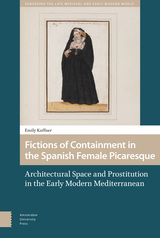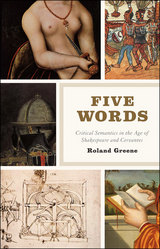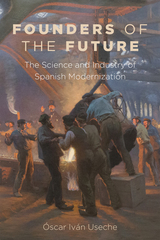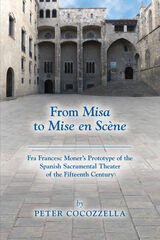117 books about Spanish & Portuguese and 5
start with F
117 books about Spanish & Portuguese and 5
117 books about Spanish & Portuguese
5 start with F start with F
5 start with F start with F

Fernan Mendez Pinto
Comedia Famosa en dos Partes
Antonio Enriquez Gomez
Harvard University Press, 1974
The editors of this volume, who have perfected the basic text and corrected printing and metrical defects, emphasize the play’s debt to the Portuguese adventurer Fernão Mendes Pinto whose prose epic (the Peregrinaçam) on the Portuguese presence in South, East, and Insular Asia inspired the Spanish work. Their introductory studies explain the play’s understandable yet false attribution to Lope de Vega and prove authorship by Antonio Enríquez Gómez, peninsular exile and ultimate victim of the Spanish Inquisition.
[more]

Fictions of Containment in the Spanish Female Picaresque
Architectural Space and Prostitution in the Early Modern Mediterranean
Emily Kuffner
Amsterdam University Press, 2019
This study examines the interdependence of gender, sexuality and space in the early modern period, which saw the inception of architecture as a discipline and gave rise to the first custodial institutions for women, including convents for reformed prostitutes. Meanwhile, conduct manuals established prescriptive mandates for female use of space, concentrating especially on the liminal spaces of the home. This work traces literary prostitution in the Spanish Mediterranean through the sixteenth and seventeenth centuries, from the rise of courtesan culture in several key areas through the shift from tolerance of prostitution toward repression. Kuffner’s analysis pairs canonical and noncanonical works of fiction with didactic writing, architectural treatises, and legal mandates, tying the literary practice of prostitution to increasing control over female sexuality during the Counter Reformation. By tracing erotic negotiations in the female picaresque novel from its origins through later manifestations, she demonstrates that even as societal attitudes towards prostitution shifted dramatically, a countervailing tendency to view prostitution as an essential part of the social fabric undergirds many representations of literary prostitutes. Kuffner’s analysis reveals that the semblance of domestic enclosure figures as a primary eroticstrategy in female picaresque fiction, allowing readers to assess the variety of strategies used by authors to comment on the relationship between unruly female sexuality and social order.
[more]

Five Words
Critical Semantics in the Age of Shakespeare and Cervantes
Roland Greene
University of Chicago Press, 2013
Blood. Invention. Language. Resistance. World. Five ordinary words that do a great deal of conceptual work in everyday life and literature. In this original experiment in critical semantics, Roland Greene considers how these words changed over the course of the sixteenth century and what their changes indicate about broader forces in science, politics, and other disciplines.
Rather than analyzing works, careers, or histories, Greene discusses a broad swath of Renaissance and transatlantic literature—including Shakespeare, Cervantes, Camões, and Milton—in terms of the development of these five words. Aiming to shift the conversation around Renaissance literature from current approaches to riskier enterprises, Greene also proposes new methods that take advantage of digital resources like full-text databases, but still depend on the interpreter to fashion ideas out of ordinary language. Five Words is an innovative and accessible book that points the field of literary studies in an exciting new direction.
Rather than analyzing works, careers, or histories, Greene discusses a broad swath of Renaissance and transatlantic literature—including Shakespeare, Cervantes, Camões, and Milton—in terms of the development of these five words. Aiming to shift the conversation around Renaissance literature from current approaches to riskier enterprises, Greene also proposes new methods that take advantage of digital resources like full-text databases, but still depend on the interpreter to fashion ideas out of ordinary language. Five Words is an innovative and accessible book that points the field of literary studies in an exciting new direction.
[more]

Founders of the Future
The Science and Industry of Spanish Modernization
Óscar Iván Useche
Bucknell University Press, 2022
In this ambitious new interdisciplinary study, Useche proposes the metaphor of the social foundry to parse how industrialization informed and shaped cultural and national discourses in late nineteenth- and early twentieth-century Spain. Across a variety of texts, Spanish writers, scientists, educators, and politicians appropriated the new economies of industrial production—particularly its emphasis on the human capacity to transform reality through energy and work—to produce new conceptual frameworks that changed their vision of the future. These influences soon appeared in plans to enhance the nation’s productivity, justify systems of class stratification and labor exploitation, or suggest state organizational improvements. This fresh look at canonical writers such as Emilia Pardo Bazán, Concha Espina, Benito Pérez Galdós, Vicente Blasco Ibáñez, and José Echegaray as well as lesser known authors offers close readings of their work as it reflected the complexity of Spain’s process of modernization.
[more]

From Misa to Mise en Scène
Fra Francesc Moner’s Prototype of the Spanish Sacramental Theater of the Fifteenth Century
Peter Cocozzella
Arizona Center for Medieval and Renaissance Studies, 2020
As both layman and Franciscan friar, the Catalan writer known as Francesc Moner (ca 1463–1495) is one of the leading exponents of the bilingual (Catalan-Castilian) culture that flourished in Barcelona in the late 1400s. In his approach to Sepultura d’amor (Burial of Love), Moner’s longest poem, Peter Cocozzella focuses on the author’s ingenious version of a kind of parody that desacralizes but does not desecrate the celebration of the funeral Mass. Cocozzella discovers the aspects of Moner’s unconventional idea of a theater based on the dramatics of the monologue and on the transformation of the divine ritual into a human analogue of transubstantiation. This allegorical pattern validates the profile of the masterpiece in question as one of the earliest manifestations of the auto sacramental, the distinctive theatrical genre scripted in the language of Castile. The book includes the text of Sepultura and its translation.
[more]
READERS
Browse our collection.
PUBLISHERS
See BiblioVault's publisher services.
STUDENT SERVICES
Files for college accessibility offices.
UChicago Accessibility Resources
home | accessibility | search | about | contact us
BiblioVault ® 2001 - 2024
The University of Chicago Press









